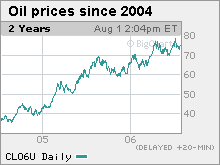|
Why oil won't go below $60 Now that OPEC has tasted record prices, the cartel won't let crude fall too far - at least for now. NEW YORK (CNNMoney.com) -- Just a couple of years back people talked about oil hitting a low of $20 a barrel. Then, as prices steadily rose without curbing worldwide demand and OPEC abandoned its target price range of $20 to $28 a barrel, people said oil wouldn't go below $40.
Now, as budgets in oil producing countries grow fat off windfall profits and worldwide demand remains unabated, some are saying that OPEC won't, at least in the short term, let the price of crude fall any lower than $60. But the cartel, which like the provider of any good must balance desire for profit against the need to keep its product popular, must watch both prices and demand as the cost of oil heads toward uncharted territory. OPEC, which pumps 40 percent of the world's oil and sits on two thirds of its reserves, has no official policy of keeping prices above $60. But some have noticed that when prices start to fall, like when they slipped into the $50s last February, some OPEC countries start to mumble about a drilling tie-up here or a maintenance related problem there - some reason why production couldn't remain at 100 percent. "You'd have a few people come out and give reasons why they have to cut sooner rather than later," said Neal Dingmann, a senior energy analyst at Pritchard Capital Partners, a Houston-based energy investment boutique. "It's funny, the last two times I've seen it is when oil is dropping." The Saudis are watching The lure of $60-a-barrel oil is obvious. Take Saudi Arabia for example, the world's largest oil producer and the 11-member cartel's heavyweight. Oil accounts for 90-95 percent of the country's total export earnings, 70 to 80 percent of government revenue, and around 40 percent of the country's gross domestic product, according to the Energy Information Administration. Since 2002 the price of oil has more than tripled. In 2004, the last year for which figures are available, the Saudi government saw a 35 percent increase in revenue, according to EIA. And that's when U.S. light crude traded mostly in the $40s. It's currently trading in the $70s. That takes a tremendous amount of pressure off a government struggling with a male unemployment rate the CIA estimates at 13 to 25 percent as well as one of the world's fastest population growth rates. OPEC says its members are not relying on this oil windfall to make ends meet. "None of the OPEC countries have come out and said they are basing their budget on prices anywhere near what you are talking about," said Omar Farouk Ibrahim, an OPEC spokesman in Vienna. Ibrahim said OPEC dropped its target price in the $20s back in 2004 after it became apparent to the cartel that forces outside its control - geopolitics, speculation and distribution problems, not fundamental supply and demand -were the prime reasons behind oil's spike. Rising supply He cited rising stockpile levels in the developed countries as evidence. "When more oil comes on the market you'd expect the price to come down," he said. "It's just fear that is leading to speculation." Ibrahim also said OPEC is well aware high oil prices could end up causing an economic slowdown that would hurt demand or, worse, prompt people to switch to other forms of fuel. "We don't want to price our commodity out of the market," he said. "We know if it gets to a certain point consumers will leave us with the oil, and then what are we going to do? We can't drink it." Other analysts, while not saying $60 explicitly, agreed OPEC would tinker with the market to keep prices high as long as it didn't spark or coincide with a drop in demand. "OPEC is clearly comfortable with a higher price," said Katherine Spector, an energy strategist at J.P. Morgan. "$50 did not impact demand" under current economic conditions. But these and other analysts also cautioned that oil is an extremely dynamic market and any attempt to predict a price floor or ceiling is almost futile. "You can't say oil won't go below $60 again," said Andrew Lebow, an energy broker at Broker at Man Financial in New York who agreed with the short-term $60 premise. "It could go to $20 or $30" in a couple of years. When asked why he saw a price floor that's so far below even the widely accepted medium-term price floor of around $40, he responded "Who in 1998 thought it could go to $75? No one." |
|



